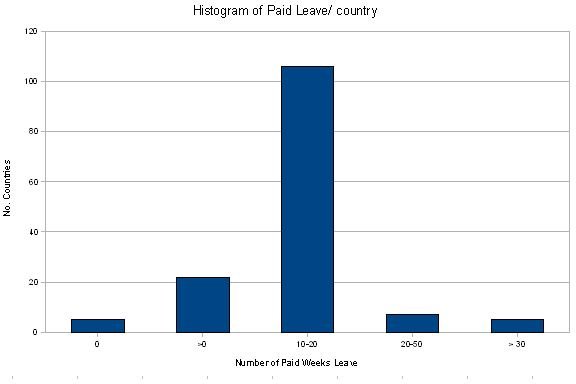No Federally Mandated Paid Maternity Leave Makes Hypocrites of Conservatives and Liberals
The Status Quo: Unpaid Maternity Leave (For Those Who Qualify)
The “Family and Medical Leave Act” (FMLA) is the main piece of legislation that gives pregnant women an opportunity to take 12 weeks of “job-protected, unpaid leave for absences due to the birth of the employee’s son or daughter and the care for the newborn child.” New moms – or moms-to-be – can only qualify for this leave if they work for a business with more than 50 workers and have logged at least 1,250 work hours for this employer in the 12 months prior to the first day of maternity leave.
Left out of this equation are the part-timers, the recently employed and those laboring in small companies or start-ups. Some protection may be had via the “Pregnancy Discrimination Act,” but only “if the employer normally provides short-term disability benefits to employees with the same tenure who are experiencing other short-term disabilities.” If there is no precedent on the book – or the company has less than 15 employees – the pregnant worker takes leave at her own risk.
Utopian Models? How European Nations Handle Paid Maternity Leave
The United States federal government mandates no paid maternity or paternity leave. According to the Clearinghouse on International Developments on Child, Youth and Family Policies at Columbia University, 1999 to 2002 figures show that the U.S. is a hold-out among industrialized nations.
- Austria offers 16 weeks of paid parental leave. The worker receives 100 percent of his or her salary.
- Denmark gives a new mom 12 months of paid leave at 60 percent of her salary.
- France allows for 16 weeks off – each – for the first two children born into a family. For a third child, mom can take off 26 weeks. Maternity and paternity leave is funded at 100 percent of the parents’ salaries.
- Germany offers 14 weeks at 100 percent pay, two years at an income-tested flat rate and a third year that is unpaid.
- The UK stipulates 18 weeks of leave, six of which will be paid at 90 percent of the parent’s salary, while the remaining 12 weeks feature a lower pay bracket.
Pardon Me, Is This Your Dagger in My Back?
The United States realizes that the currently unpaid model is untenable. To be fair, there are ample states that have cobbled together legislation to augment FMLA policies to give moms at least access to some disability benefits while on leave. Politicians on both sides of the aisle have been conspicuously quiet when it comes to ushering the U.S. maternity leave provisions into the 21st century.
Behind the scenes, however, there is evidence that the federal government is concerned about retaining new moms. To sweeten the deal, there was talk of creating a new entitlement that would have – as outlined by a Report to Congress on Paid Parental Leave – entitled the (then) 350,000 female civilian federal employees to six weeks of paid maternity leave at a cost of “$5,000 per female employee.” Since this was to be a parental leave policy, it would have also benefitted another 380,000 male workers. The cost of this entitlement – had it gone through – would have cost taxpayers approximately $1 billion between 2001 and 2005. These taxpayers, as you might imagine, are men and women who would love to benefit from paid maternity and paternity leaves, but who are living paycheck to paycheck and could not possible take off 12 weeks unpaid. Would they appreciate a six-week paid leave?
The November 21, 2001 Memorandum for Human Resources Directors concluded that “Federal Executive departments and agencies overwhelmingly indicated that an additional paid parental leave benefit would not be a major factor in enhancing their recruitment and retention situations.” Hence, the movement to give federal workers a benefit that would put them almost on par with worker benefits in the European Union fizzled.
Of Lip Service and Hypocrisy

Politicians tend to champion the causes they perceive to be safe. Expressing breast milk at work is a good example of a safe topic that features a bit of controversy, but overall generates sympathy, empathy and just makes sense. Not surprisingly, it is easy to find lawmakers who jump on the bandwagon.
Paid maternity leave, on the other hand, raises the ugly specter of “socialism,” the battle cry of the conservative politician looking for a foothold in the perennial campaign season against a liberal opponent. Rather than standing up to the label, liberal lawmakers act cowardly and do not touch paid maternity leave benefits. As a result, the United States experiences the FMLA status quo.
While all politicians wave the banner of family values, the fact that – as outlined by the Berkeley Center on Health, Economic & Family Security – “women who take pregnancy disability leave experience positive health benefits, including a reduced risk of Caesarean section, increased breastfeeding, and reduced post-partum depression. And parental leave has significant positive effects on the health of young children, maternal health, and fathers’ involvement with their babies” (emphasis mine).
Being able to afford staying home with a new baby is only possible if paternity and maternity leaves are paid. If politicians were truly serious about slashing the high percentage of single parent homes (29.5 percent as of 2008) that are largely mom-led and dad-absent, why do they ignore the elephant in the room?
References
- Report to Congress on Paid Parental Leave, http://www.opm.gov/oca/leave/html/ParentalReport.htm
- Memorandum for Human Resources Directors, http://www.opm.gov/oca/leave/html/CPM2001-11.htm
- Photo Credit: “Graph of Maternity Leave in Americas” by Seabhcan/Wikimedia Commons via public domain
- US Census Bureau, http://www.census.gov/compendia/statab/2011/tables/11s1336.pdf
- Clearinghouse on International Developments on Child, Youth and Family Policies at Columbia University, http://www.childpolicyintl.org/familyleavetables/Table%201.11%20Maternity%20&%20Parental%20Leaves.pdf
- Photo Credit: “Histogram of countries by weeks paid maternity leave provided by law” by Seabhcan/Wikimedia Commons via public domain
- Berkeley Center on Health, Economic & Family Security, http://www.working-families.org/learnmore/reforming_fmla.pdf
